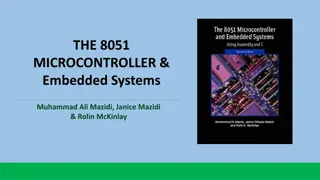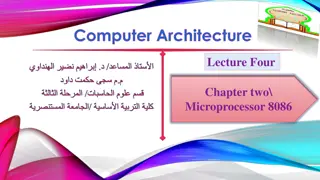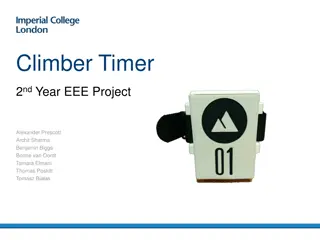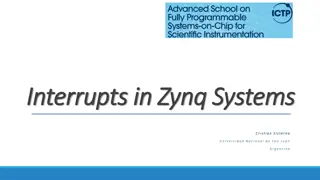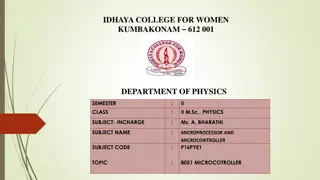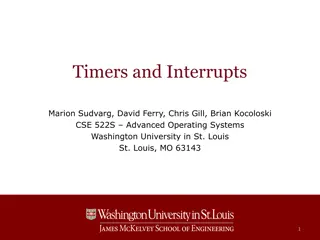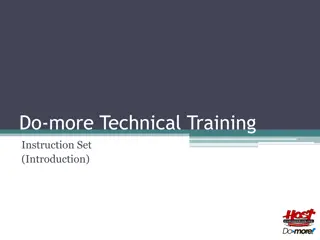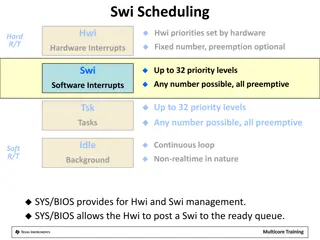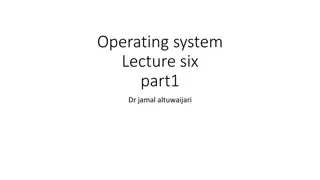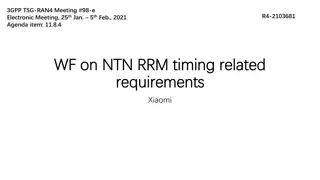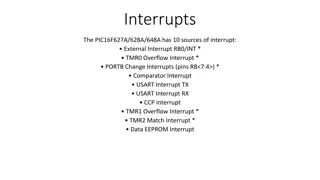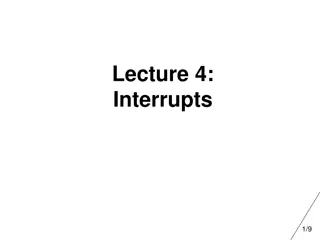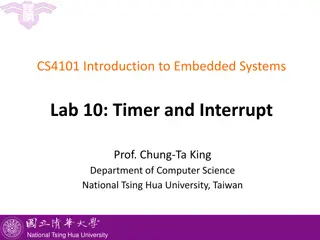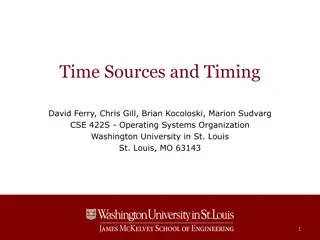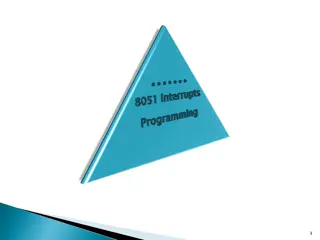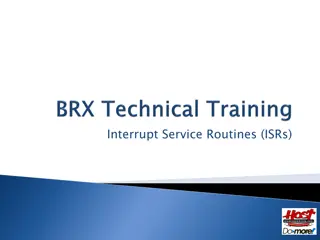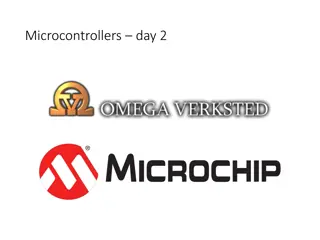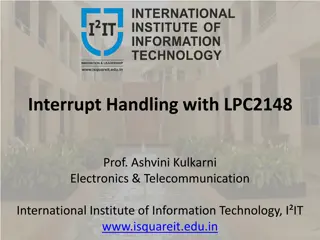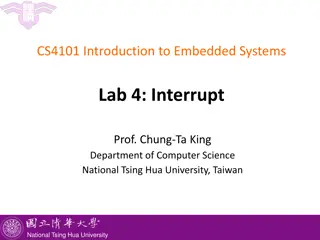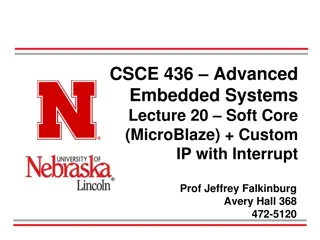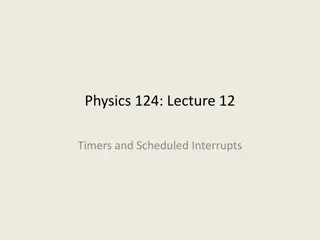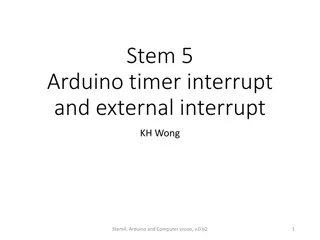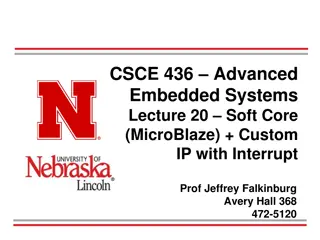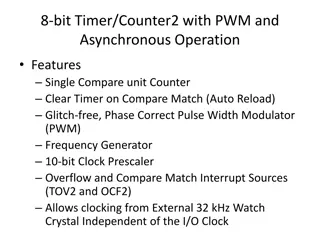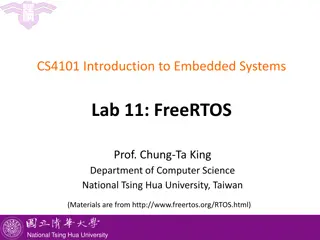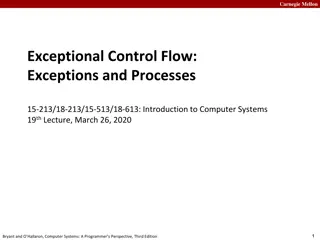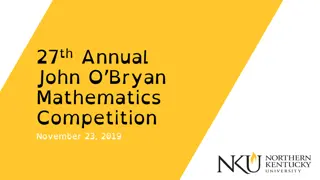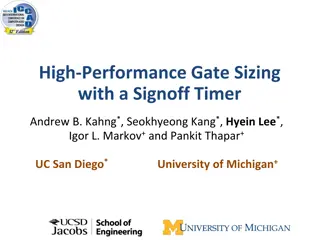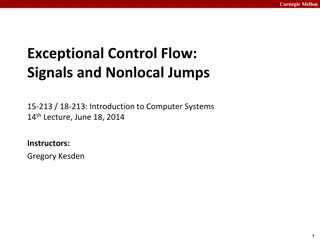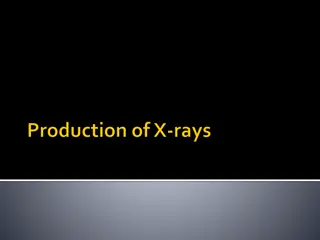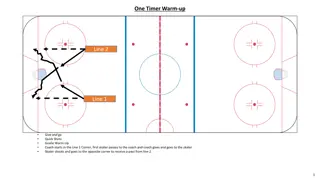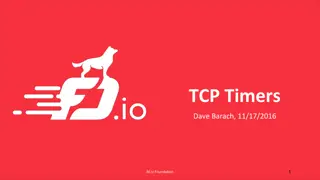Address Prediction and Recovery in EECS 470 Lecture Winter 2024
Explore the concepts of address prediction, recovery, and interrupt recovery in EECS 470 lecture featuring slides developed by prominent professors. Topics include branch predictors, limitations of Tomasulo's Algorithm, various prediction schemes, branch history tables, and more. Dive into bimodal,
0 views • 42 slides
Introduction to 8051 Microcontroller Timer Programming
Explore the world of 8051 microcontroller timer programming through this comprehensive guide. Learn about the timers, their registers, modes, and how to program them in Assembly and C language to generate time delays and event counters. Delve into examples to understand timer selection, clock freque
1 views • 46 slides
Understanding Flag Registers in Microprocessor 8086
This content discusses the flag registers in the Microprocessor 8086, covering conditional flags such as Carry Flag (CF), Auxiliary Flag (AF), Parity Flag (PF), Zero Flag (ZF), Sign Flag (SF), and Overflow Flag (OF), as well as control flags including Trap Flag (TP), Interrupt Flag (IF), and Directi
1 views • 23 slides
Climber Timer: Innovative Climbing Center Solution by EEE Project Team
Climber Timer is an innovative solution developed by a team of EEE project members to help climbers easily time and log their climbs at climbing centers. The device is designed to retrofit onto existing walls and offers features like ascent time recording, auditory feedback, and data upload capabili
0 views • 24 slides
Techniques for Reducing Connected-Standby Energy Consumption in Mobile Devices
Mobile devices spend a significant amount of time in connected-standby mode, leading to energy inefficiency in the Deepest-Runtime-Idle-Power State (DRIPS). This study introduces Optimized DRIPS (ODRIPS) to address this issue by offloading wake-up timer events, powering off IO signals, and transferr
1 views • 31 slides
Understanding Processor Interrupts and Exception Handling in Zynq Systems
Learn about interrupts, exceptions, and their handling in Zynq Systems. Explore concepts like interrupt sources, Cortex-A9 processor interrupts, interrupt terminology, and the difference between pooling and hardware interrupts. Gain insights into interrupt service routines, interrupt pins, interrupt
1 views • 60 slides
Understanding the 8051 Microcontroller: Features, Registers, and Applications
A detailed overview of the 8051 microcontroller including its introduction, features, and registers. Explore how the 8051 is useful for small computing tasks, control applications, and its low power consumption. Learn about the various registers in the 8051 such as the accumulator, program counter,
0 views • 18 slides
Understanding Timers and Interrupts in Operating Systems
This content discusses the importance of timers and interrupts in operating systems, focusing on how they facilitate preemptive multitasking. It covers how hardware timer interrupts help in preemption of processes by the kernel, ensuring efficient task scheduling and resource management in modern op
4 views • 18 slides
Comprehensive Introduction to Technical Training Instruction Set
Delve into the basics of technical training instruction sets covering 181 different instructions. Explore key concepts such as coil/bit output, analog/process control, program looping, timer/counter functions, and more. Understand the operational characteristics of different instruction categories,
0 views • 19 slides
Real-Time Interrupt Handling and Scheduling in SYS/BIOS
This content covers the management of hardware and software interrupts, interrupt priorities, scheduling rules, and execution flow for real-time systems using SYS/BIOS. It discusses the handling of interrupts by the Hardware Interrupt (Hwi) and Software Interrupt (Swi) components, priority levels, p
0 views • 4 slides
Understanding Interrupt Processing in Operating Systems
An interrupt in an operating system disrupts the normal sequence of instructions executed by the processor. When an interrupt occurs, the OS takes control, saves the state of the interrupted process, analyzes the interrupt, and passes control to the appropriate routine. There are six classes of inte
0 views • 15 slides
NTN RRM Timing Related Requirements for Xiaomi Devices at 3GPP TSG-RAN4 Meeting #98-e
The agenda item for the 3GPP TSG-RAN4 Meeting #98-e involves discussing NTN RRM timing related requirements, specifically focusing on UE timing synchronization for Xiaomi devices. Key aspects include UE transmit timing error limits, timing advance accuracy, and UE timer accuracy requirements for NTN
0 views • 6 slides
Understanding Interrupts in PIC16F Microcontrollers
Explore the key sources of interrupts in PIC16F627A/628A/648A, accessing registers, enabling interrupts, and managing local interrupts such as Timer 0 alarms and B0 pin changes. Learn how to set interrupts on desired events and understand the corresponding flag bits for interrupt occurrence.
0 views • 17 slides
Understanding Interrupts and Timers in Microcontrollers
Microprocessors function as finite state machines, with instructions loaded from memory and executed in sequence. However, interrupts allow for urgent out-of-turn servicing of signals, providing a way to handle asynchronous events. Learn how to utilize interrupts efficiently with examples on Arduino
0 views • 9 slides
Embedded Systems Lab 10: Timer and Interrupt
This lab focuses on learning about timers and interrupts in embedded systems using MQX at National Tsing Hua University. It covers creating timer components, starting timers, and provides examples on simulating the control of an LED using timers. The content includes code snippets and explanations r
0 views • 15 slides
Understanding Time Management in Operating Systems
Explore the concept of time in computer systems, including absolute and relative time, how the kernel tracks time, real-time clocks, system timers, and timer interrupts. Discover how time is a critical resource utilized by operating systems to provide essential functions for users.
0 views • 25 slides
ARM Cortex-M Interrupt and Exception Programming Overview
Explore the fundamentals of interrupts and exceptions programming in ARM Cortex-M microcontrollers. Topics include interrupt handling mechanisms, interrupt vector table, interrupt priorities, control registers, and transitioning from reset to boot programs. Gain insights into the privileged executio
0 views • 31 slides
Understanding Interrupts in 8051 Microcontroller
Interrupts in 8051 microcontrollers allow the system to respond to asynchronous events while multitasking on a single CPU, giving the illusion of handling many things simultaneously. They introduce the concept of priority, enabling preference over simultaneous interrupts. The interrupt vectors deter
0 views • 13 slides
Understanding Timers and Time Tracking in Embedded Systems
Explore the importance of timers in embedded systems for tracking time, managing interrupts, and ensuring accurate timekeeping. Learn about different peripherals used, such as real-time clocks and processor timers, to handle tasks like updating UI elements, triggering alarms, and measuring intervals
0 views • 24 slides
Understanding Interrupt Service Routines (ISRs) in PLC Programming
Interrupt Service Routines (ISRs) are crucial in handling interrupting events in programmable logic controller (PLC) systems that require immediate attention. They can be triggered by events, timers, and register matches, executing outside the normal ladder scan. ISRs have priority order for handlin
0 views • 5 slides
Understanding Fundamental Concepts of Interrupts in Embedded Systems
Explore the fundamental concepts of interrupts in embedded systems, including interrupt handling, maskability, priority, service routines, and interrupt vectors. Learn how interrupts allow the CPU to handle special events efficiently, coordinate I/O activities, and prevent CPU tie-up, enhancing syst
0 views • 57 slides
Understanding Microcontroller Interrupts and Applications
Explore the fundamental concepts of interrupts, PWM, timer/counters, and ADC in microcontrollers. Learn how to use interrupts for tasks like LED blinking, control LED brightness with PWM, and read voltage using ADC. Get insights on interrupt routines, enabling interrupts through registers, and tips
0 views • 32 slides
Understanding Interrupt Handling with LPC2148 in Electronics & Telecommunication
Introduction to interrupt handling with LPC2148 focusing on ARM processors, IRQ, FIQ, associated registers, interrupt enabling, types of interrupts (FIQ, Vectored IRQ, Non-Vectored IRQ), and differences between Vectored and Non-Vectored interrupts in the context of LPC2148. Discusses interrupt sourc
0 views • 15 slides
Understanding Interrupt Handling in MSP430 Embedded Systems
This lab explores the intricacies of handling interrupts in MSP430, covering types of interrupts, enabling interrupts, and the execution flow when an interrupt is requested and serviced. Topics include interrupt service routines, clearing interrupt flags, and enabling/disabling maskable interrupts.
0 views • 23 slides
Understanding Interrupts and MicroBlaze in Advanced Embedded Systems
Dive into the world of interrupts in embedded systems with a focus on MicroBlaze architecture. Learn how interrupts enable multitasking, the process of handling interrupts, and generating interrupts in MicroBlaze. Explore custom IP integration and gain insights into interrupt-driven programming. Dis
0 views • 32 slides
Understanding Timers and Scheduled Interrupts in Physics 124
The lecture covers timer basics for Arduino Uno/Nano, discussing available timers, prescaler options, PWM frequencies, and implementation details. It explains prescaling and frequency concepts, wrap times for Timer0, Timer1, and Timer2, and the importance of timed interrupts for creating a schedule
0 views • 21 slides
Understanding Arduino Timer and External Interrupts
Interrupts play a crucial role in Arduino programming, allowing for immediate responses to external events. This content covers the concepts of timer interrupts and external interrupts, their applications, and how to use them effectively in Arduino projects. It explains how interrupts work, provides
0 views • 11 slides
Understanding Interrupts in Embedded Systems using MicroBlaze
Dive into the world of interrupts in embedded systems with a focus on using the MicroBlaze soft core processor and custom IP to handle interrupts efficiently. Learn about the significance of interrupt service routines, interrupt handling process, and how to generate interrupts in MicroBlaze for seam
0 views • 30 slides
Understanding the Watchdog Timer in Embedded Systems
Explore the purposes and modes of the watchdog timer, learn how to activate and program it in interval timer mode, and understand the process of disabling it using predefined passwords. Discover the importance of the watchdog timer in recovering from software errors, conflicts between software and h
0 views • 28 slides
8-bit Timer/Counter2 with PWM and Asynchronous Operation
The 8-bit Timer/Counter2 with PWM and Asynchronous Operation features single compare unit, glitch-free operation, phase-correct PWM, frequency generator, clock prescaler, interrupt sources, and external clocking options. It includes registers for control, counter, output compare, asynchronous status
0 views • 14 slides
Understanding FreeRTOS for Real-Time Embedded Systems
Learn about task and timer management in FreeRTOS, porting FreeRTOS onto NuMaker TRIO, and ensuring timely responses to real-world events. Discover how FreeRTOS measures time, task scheduling, and using timers effectively for real-time embedded systems.
0 views • 22 slides
Understanding Exceptional Control Flow in Computer Systems
Exceptional control flow in computer systems involves mechanisms such as exceptions, process context switches, signals, and nonlocal jumps to handle changes in system state or events. These mechanisms allow for efficient responses to events like data arriving from external sources, user interactions
0 views • 66 slides
Math Challenge - Solve Four Questions within Three Minutes Each!
Test your mathematical skills with four challenging questions in this timed math competition. Solve each question within three minutes, without using a calculator. Be quick and accurate to score points based on the correctness of your answers. Fold and submit your answer sheet within five seconds af
0 views • 37 slides
High-Performance Gate Sizing with Signoff Timer: VLSI Design Challenges
This study delves into the intricate realm of gate sizing in VLSI design, focusing on optimizing power and delay through effective approaches and addressing challenges such as interconnect delay, inaccurate internal timers, and critical paths. Previous gate sizing techniques are evaluated, and a met
0 views • 34 slides
Understanding Multitasking and Exceptional Control Flow in Computer Systems
Explore the intricacies of multitasking and exceptional control flow in computer systems as taught in Carnegie Mellon's 15-213/18-213 course. Delve into topics like signals, nonlocal jumps, bits, bytes, integers, floats, assembly, stack discipline, cache linking, process context switch, hardware tim
0 views • 44 slides
A Detailed Look into X-Ray Machine Components
This content explores various components of an X-ray machine, including the control panel extension arm tube head, on/off switch, exposure button, digital timer, warning lights, and more. It delves into the functions and structures of essential parts like the metal housing, X-ray tube, transformer,
0 views • 20 slides
Hockey Drills for Skill Development: One-Timer Warm-up, Puck Possession, Tic Tac Toe, Cycle 2-on-1, Defensive Zone Coverage
Enhance your hockey skills with a series of drills focusing on quick shots, puck possession, defensive tactics, and strategic plays. From one-timers to cycling the puck, these exercises cover various aspects of the game to help you sharpen your abilities on the ice.
0 views • 5 slides
Dynamic Channel Switch Operation in IEEE 802.11-24 Standard
STAs in IEEE 802.11-24 can dynamically switch to secondary channels per the AP's request for frame exchanges. The process involves soliciting control frames, determining parking channels, managing frame exchanges, and switching back to the primary channel at the end of a TXOP. Various examples illus
1 views • 11 slides
First-Timer’s Guide to Private Jet Travel in Los Angeles
Discover everything you need to know for your first private jet trip in Los Angeles, from booking tips to what to expect onboard.
1 views • 5 slides
Understanding TCP Timers and Timer Wheels
Explore the purpose-built TCP timers designed by Dave Barach for fd.io Foundation. Delve into the two-level wheel algorithm with a timer granularity of 100ms, capable of handling up to 20 million concurrent timers. Learn about the timer wheels' operation, APIs for starting, stopping, and processing
0 views • 11 slides

